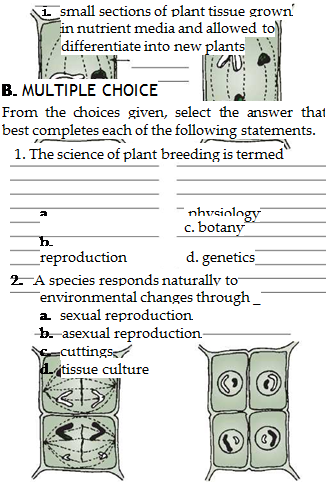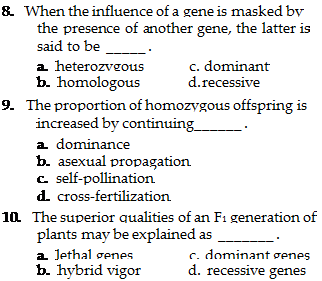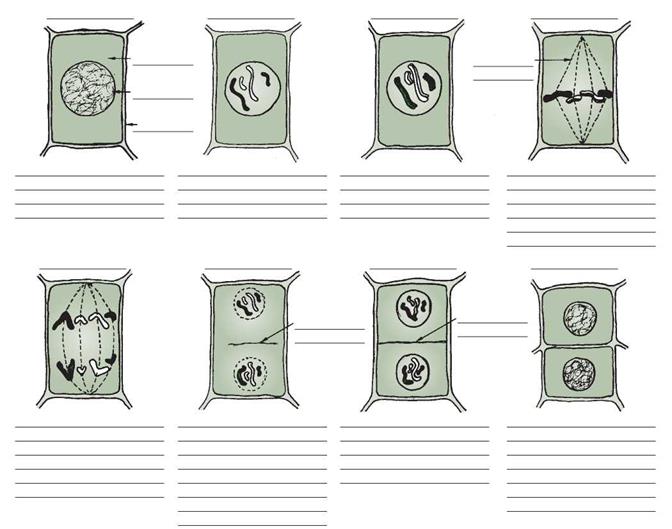Mutations are spontaneous changes in the genetic structure of a plant. They occur in nature as accidents, resulting from something that prevents the DNA of a chromosome from replicating exactly during meio – sis. The cause of the incomplete replication may or may not be identifiable, but once done, the new plant is different in some way from what was expected. Most significant is that the difference is now part of the genetic code of the new plant, making it heritable. Mutations may also be induced by plant breeders using chemical or radiation methods to create new plants possessing desired features.
INDUSTRY APPLICATIONS_________________________
Plant breeders apply their knowledge of genetics and their ability to influence plant reproduction to develop new varieties that meet a need. The nature of the need is defined and described by the people who will then produce the new plants in quantity.
Working in universities and in private research centers around the world, plant breeders attempt to create plants that will solve problems. Improved resistance to pests, drought, or herbicides are typical benefits sought through breeding programs. Other breeders may seek to change a species of plant to make its harvest easier, or its flowers larger, or its foliage more glossy. Because plant breeding is expensive and time consuming, and not totally predictable, time cannot be wasted on changes that are not sought by growers or consumers.
SUMMARY______________________________________
When organisms duplicate themselves, the process is termed reproduction. If deliberately controlled and manipulated, it is termed propagation. Plant reproduction may be either sexual or asexual.
Sexual reproduction is accomplished through the formation of seeds and requires the fusion of two sex cells (gametes). Each gamete has one set of chromosomes and is termed haploidal. Fusion results in a cell or zygote that has two sets of chromosomes and is termed diploidal. The gametes are formed in the process of meiosis which reduces the number of chromosomes in each cell by half. Through sexual reproduction, the genetic material of the cell recombines, resulting in new plants that differ from their parent plants in physical or physiological characteristics.
Asexual reproduction is a vegetative process that eliminates genetic variation. It can perpetuate an individual plant unchanged for many years. Asexual reproduction is made possible by a combination of the processes of mitosis and cytokinesis. Mitosis is the normal division of a cell nucleus that occurs as a plant grows. Cytokinesis is the division of the remainder of the cell’s contents and the formation of a new cell wall. There is no reduction and recombination of the chromosomes as the cells divide, and no opportunity for a new plant to be initiated.
As reproduction is both sexual and asexual, so, too, is plant propagation. Sexual propagation utilizes seeds. Not all seeds require the same environment for germination. Some seeds need light; others require darkness to germinate. Some seeds remain dormant due to an impervious seed coat and require scarification, or breaking of the seed coat, in order to germinate. Others require a period of low temperatures, or stratification, before germination can occur.
Asexual propagation utilizes the vegetative parts of a plant to grow new plants. Stems, roots, and leaves can be used since each vegetative cell has the ability to reproduce an entire plant that is genetically identical to the one from which the cell originated. Asexual propagation techniques include use of:
• runners
• stolons
• sucker shoots
• bulbs and similar organs
• layering
• cuttings
• grafting
• budding
• division of the crown
• tissue culture
• apomictic embryos
The essence of asexual reproduction is that there is no change in the new plants. Although this may be desirable in the short term, over time plants must be able to change and respond to new environmental conditions. Such changes can only occur through sexual reproduction or spontaneous mutation.
Plant breeding is the deliberate control of the sexual reproduction process. The science of plant breeding is known as plant genetics and began in the late 1800s with Gregor Mendel’s study of the common garden pea. His work disproved the previously held belief that inheritance in plants is not predictable. It is now commonly accepted that all physiological activities of plants as well as their physical appearance are controlled by individual genes, the determiners of heredity. The genes are located on chromosomes in the nucleus of each plant cell. Chromosomes and their genes are duplicated and distributed through meiosis. Depending on whether plants are self-pollinated or crosspollinated, and how many independently inherited characteristics distinguish the parents, the offspring may closely resemble the parents or be very different. Survival and adaptability of plant species to new environments depend on the variations that result from sexual reproduction.
ACHIEVEMENT REVIEW
A.  SHORT ANSWER
SHORT ANSWER
1. Briefly define the following terms:
a. reproduction
b. propagation
c. sexual propagation
d. asexual propagation
|
3.
 |
 |
Label each stage in this diagram of meiosis.
a.
 |
 |
F1 hybrid c. dihybrid cross
b. F2 hybrid d. monohybrid
cross
![]()




